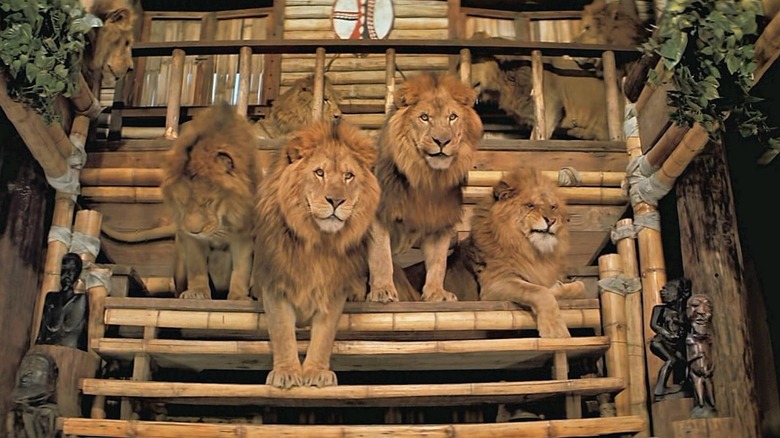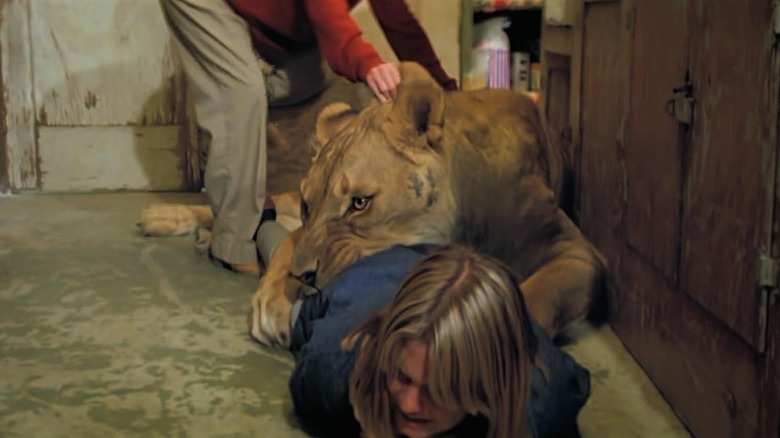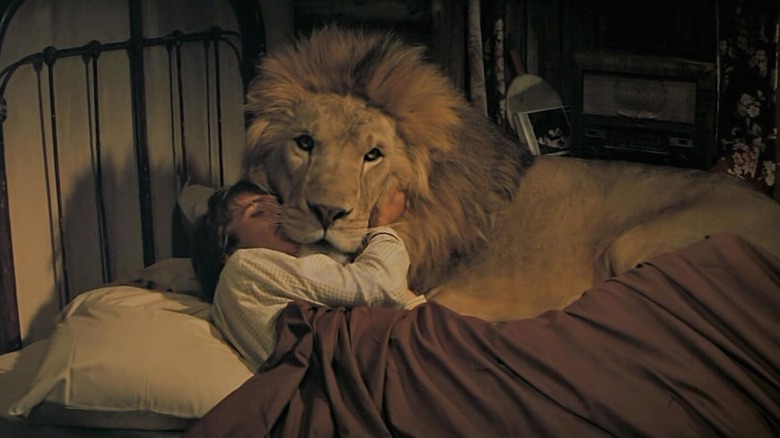How The Director Of Twister Ended Up On The Wrong End Of A Lion Attack
Making a motion picture is hard work under the best of circumstances. It's a collaborative process that requires careful, hopefully cordial coordination between an incredibly diverse array of craftspeople: directors, actors, writers, camera operators, designers, stunt people, electricians, carpenters, animal wranglers, and occasionally muppets. The degree of difficulty gets ratcheted up when you dare to shoot in less-than-welcoming elements like the water, the jungle, or the desert.
"Jaws," "Apocalypse Now," and "Lawrence of Arabia" are three of the greatest films ever made, but they were brutally difficult to pull together. Mother Nature's fury knocked all three of these well behind schedule. Sets were wrecked, equipment was damaged beyond repair and a mechanical shark refused to operate properly. Was it worth it? For the viewer, absolutely. You watch these movies and, in between breathtaking sequences, lament that they really couldn't be made in this risk-taking fashion nowadays. But one viewing of George Hickenlooper, Fax Bahr, and Eleanor Coppola's "Hearts of Darkness: A Filmmaker's Apocalypse" should leave you thanking the maker of your choosing that you were subjected to Francis Ford Coppola's controversial approach to "Apocalypse Now" while he turned the Philippines into a war zone.
And then there is Noel Marshall's "Roar."
The passion project of Marshall and his movie star wife Tippi Hedren, "Roar" is, on the surface, a family film about a naturalist (Marshall) who runs a nature preserve in Tanzania populated by big cats. When he brings his family (the actual Marshall-Hedren clan, including a young Melanie Griffith) out to join him while he continues his study, all hell breaks loose. They arrive while he is off dealing with a threat to the preserve, which leads to a harrowing encounter with these giant creatures (who will play with you until you're dead like a housecat would a mouse). It's all terrifyingly real, and the peril is unrelenting until the credits roll 90 minutes later, at which point you're wondering how no one got killed shooting this wild thing.
Amazingly, no one perished while filming "Roar," but Jan de Bont — the legendary Dutch filmmaker and cinematographer who lensed "Die Hard" and "The Hunt for Red October," and directed "Speed" and "Twister" — flirted with the big exit when he got full-on scalped by a playful lion.
At least 70 people were injured during the production of Roar
Jan de Bont was a promising young director of photography in the early 1970s. He'd earned renown in his native Netherlands by shooting Paul Verhoeven's first three features ("Business Is Business," "Turkish Delight," and "Keetje Tippel"), but what he really wanted to do was work in Hollywood. So, when he was offered the opportunity to be the cinematographer on a project directed by the executive producer of "The Exorcist," he leapt at it.
If de Bont had known ahead of time that he would become a part of a production that would be shot and re-shot over five years, he might've waited to make the move to Hollywood. But he was young and ambitious and perhaps figured that "Roar," which boasted a crew of experienced animal trainers, wouldn't devolve into the kind of recklessness that left somewhere around 70 people nursing injuries ranging from slight to near-fatal.
In a 2020 interview with Vulture's Bilge Ebiri, de Bont reflected on his "Roar" experience. While he was impressed by Marshall's "The Exorcist" credit, the alarm bells went off when he was informed that "Roar" would require five months of principal photography. "I mean, the longest movie in Europe in those days was five or six weeks," de Bont explained. "I couldn't really imagine that you could work that long on one movie." Nevertheless, he took the gig, and soon found himself on what he called "a trip through hell." As he told Ebiri, "We had animals escape. We had a flood destroying the whole set. We had a fire destroying the whole set. Each time, everything had to be rebuilt. We had people getting injured left and right."
That's when his scalp got torn open like a can of mixed vegetables.
Jan de Bont got scalped by a lion while filming Roar
The filmmaker's very bad day occurred while he was shooting a scene with Tippi Hedren and Melanie Griffith floating in a boat on a lake while lions attempt to get at them. "We were filming on the lake with multiple cameras," de Bont recalled, "And one was in a hole in the ground, which the lions are supposed to run over as the camera would pan to Melanie and Tippi in the boat screaming." The filmmaker was, quite unfortunately, in that hole. Per the man who should've won an Oscar for shooting "Basic Instinct":
"[O]ne lion smelled there was something there, and he put his head in the hole. It's a very small hole, and he grabbed my head, and he totally scalped me. I couldn't see anything. My skin was hanging in front of my eyes, my face, and all I felt was some bloody mass and gushing blood. I remembered that I'd been told to make yourself as big and as loud as you can. So I stood up, but not knowing where the lion exactly was, I kept rotating. My assistant who was next to me under the camera, he had fainted — and good for him, he was down below."
It was such a chaotic scene that it took the trainers a while to figure out what had happened to de Bont. Once they finally chased the lions away with fire extinguishers, de Bont was rushed off to the hospital, where he had to hang out for a long time without his scalp attached to his skull because the doctors were worried about the gaping wound getting infected.
Amazingly, 220 stitches later, this was not de Bont's last day on the set of "Roar." How could he possibly go back? His answer is chilling:
"Let me tell you why I kept working: because I had such nightmares from that episode, and the nightmare was mostly about the teeth of the lion on my skull. You know what that sound is that you make on the chalkboard? The scratching sound, but a hundred times stronger. The teeth on both sides of your skull in stereo, because that's how I remember it — stereophonic sound. I woke up every night. The doctor said, 'Maybe you should go and visit them.' And then I decided to go back for a short time."
It's not such a bad thing that a movie like "Roar" could never be made again, but like "Jaws," "Apocalypse Now," and "Lawrence of Arabia," I'm so very grateful that these artists risked their lives to capture something so bizarrely raw and, at times, lighthearted. I would not, however, trade de Bont's subsequent filmography for this one movie. Not even "The Haunting." I think.


